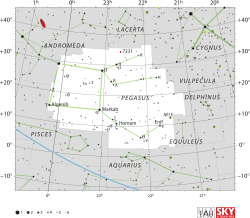Alpha Pegasi
- This article is about the star named Markab, for alternate meanings, see Markab (disambiguation).

| |
| Observation data Epoch J2000 Equinox J2000 | |
|---|---|
| Constellation | Pegasus |
| Right ascension | 23h 04m 45.65345s[1] |
| Declination | +15° 12′ 18.9617″[1] |
| Apparent magnitude (V) | 2.48[2] |
| Characteristics | |
| Spectral type | B9 III |
| U−B color index | –0.06[2] |
| B−V color index | –0.04[2] |
| Astrometry | |
| Radial velocity (Rv) | –2.2[3] km/s |
| Proper motion (μ) | RA: 60.40 ± 0.17[1] mas/yr Dec.: -41.30 ± 0.16[1] mas/yr |
| Parallax (π) | 24.46 ± 0.19[1] mas |
| Distance | 133 ± 1 ly (40.9 ± 0.3 pc) |
| Details | |
| Radius | 4.72 ± 0.14[4] R☉ |
| Surface gravity (log g) | 3.51 ± 0.03[4] cgs |
| Temperature | 9,765 ± 63[4] K |
| Metallicity [Fe/H] | −0.02 ± 0.10[4] dex |
| Rotational velocity (v sin i) | 125[5] km/s |
| Other designations | |
Alpha Pegasi (α Peg, α Pegasi) is the third brightest star in the constellation Pegasus and one of the four stars in the asterism known as the Great Square of Pegasus. It has the traditional name Markab (or Marchab), which comes from an Arabic word مركب markab, "the saddle of the horse", or is mistranscription of Mankib comes from an Arabic phrase منكب الفرس Mankib al-Faras, "(the Star of) the Shoulder (of the Constellation) of the Horse" for β Pegasi.
Markab has a stellar classification of B9 III, indicating that it is a B-type giant star that has exhausted the hydrogen at its core and has evolved beyond the main sequence. It is rotating rapidly, with a projected rotational velocity of 125 km/s giving a lower bound on the azimuthal velocity along the star's equator. The effective temperature of the photosphere is nearly 10,000 K and the star has expanded to nearly five times the radius of the Sun.
References
- ↑ 1.0 1.1 1.2 1.3 1.4 van Leeuwen, F. (November 2007), "Validation of the new Hipparcos reduction", Astronomy and Astrophysics 474 (2): 653–664, arXiv:0708.1752, Bibcode:2007A&A...474..653V, doi:10.1051/0004-6361:20078357
- ↑ 2.0 2.1 2.2 Johnson, H. L. et al. (1966). "UBVRIJKL photometry of the bright stars". Communications of the Lunar and Planetary Laboratory 4 (99). Bibcode:1966CoLPL...4...99J.
- ↑ Wielen, R. et al. (1999), Sixth Catalogue of Fundamental Stars (FK6). Part I. Basic fundamental stars with direct solutions (35), Astronomisches Rechen-Institut Heidelberg, Bibcode:1999VeARI..35....1W
- ↑ 4.0 4.1 4.2 4.3 Fitzpatrick, E. L.; Massa, D. (March 2005), "Determining the Physical Properties of the B Stars. II. Calibration of Synthetic Photometry", The Astronomical Journal 129 (3): 1642–1662, arXiv:astro-ph/0412542, Bibcode:2005AJ....129.1642F, doi:10.1086/427855
- ↑ Abt, Helmut A.; Levato, Hugo; Grosso, Monica (July 2002), "Rotational Velocities of B Stars", The Astrophysical Journal 573 (1): 359–365, Bibcode:2002ApJ...573..359A, doi:10.1086/340590
| ||||||||||||||||||||||||||||||||||